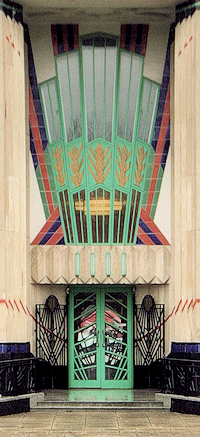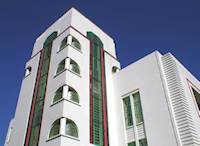Hoover Building
Fancy supermarket
The Hoover Building, Western Avenue, Perivale

The Guide wouldn’t as a rule feature a supermarket, even one belonging to a business that began on a market stall in South Hackney, set up by Whitechapel-born Jack Cohen in 1919. But this particular branch of Tesco’s occupies a former factory that’s one of London’s finest art deco landmarks.
Modern warehouses and manufacturing plants tend to be shed-like blots on the landscape but the interwar years were a golden age for industrial architecture. In particular, American corporations spared no cost in setting up European bases that would serve as showcases for their products. In the 1920s and 30s prestigious factories lined newly-built arterial highways like the Great West Road (primarily along its so-called Golden Mile, in Brentford) and the Eastern and Western Avenues. Some of these striking structures fell victim to the Luftwaffe’s bombs, others to rapacious postwar developers, but a few survive, almost all now turned to other uses.
In 1931 Ohio-based vacuum cleaner makers the Hoover Company commissioned Wallis, Gilbert and Partners to create a factory on the Western Avenue in Perivale. The London-based architectural partnership – initially Wallis, Gilbert & Partner, singular – had been founded in 1916, primarily for the purpose of collaborating with an American company that specialised in providing the reinforcement technology and materials for large concrete factories.
The partnership was commissioned to work on several monumental projects, including Victoria coach station and factories for Wrigley’s chewing gum in Wembley, the Gramophone Company in Hayes, and Firestone tyres, Pyrene fire extinguishers and Coty cosmetics, all on the Great West Road. Incidentally, there’s no evidence that there ever was a Gilbert at Wallis, Gilbert and Partners, nor that there was originally any other partner. Gilbert and his anonymous colleague may have been invented by the genuine founder, Thomas Wallis, simply to make his practice sound bigger than it was.
Modern architectural commentators generally treat the Hoover factory as an art deco design, but Thomas Wallis called his style ‘Fancy’. The building’s ornamentation is said to have been inspired by the art of Central and North American Indians, though there are Egyptian touches too.
 The Hoover factory opened in 1933 and work on various extensions (upwards as well as outwards) and outbuildings continued almost until the outbreak of the Second World War. It was this piecemeal process that’s to blame for the most legitimate criticism that can be aimed at the factory: its lack of a cohesive overall form. Early critics also condemned what they saw as its brash, vulgar style, but the company and its employees liked it and so did the general public.
The Hoover factory opened in 1933 and work on various extensions (upwards as well as outwards) and outbuildings continued almost until the outbreak of the Second World War. It was this piecemeal process that’s to blame for the most legitimate criticism that can be aimed at the factory: its lack of a cohesive overall form. Early critics also condemned what they saw as its brash, vulgar style, but the company and its employees liked it and so did the general public.
Vacuum cleaner production ceased in 1982 and the Hoover factory closed. It reopened ten years later – magnificently restored, with the rear ground floor converted into a Tesco superstore. Although the building’s glory resides primarily in its sweeping white façade, there are some pleasing design touches in and around the rear car park too, but not inside the store, which sadly looks like any other.
The rest of the building was used as offices (or for nothing at all) until March 2018, when IDM Developments completed a swanky residential conversion with some delightful art deco details and – equally delightfully – fitted ovens made by Hoover.
Property developers Amro Real Estate Partners are proposing to build a 22-storey residential tower on the site of the Tesco petrol station behind the old factory, in a pastiche art deco style that will conflict with the Hoover Building rather than complement it. Objectors to the scheme have started a petition seeking to have the plans rejected – or at least scaled down, as Historic England have recommended.

